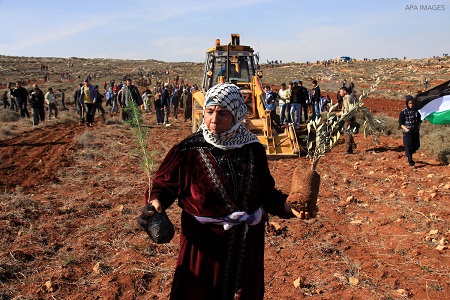Gaza: Food Sovereignty under Fire

While we do not yet know the full extent of the environmental impacts that Israeli occupation measures have had on Gaza over the past several years, one point is certain: Israel’s central objective is to thoroughly deprive Palestinians of their natural resources and livelihoods.
Today, the people of Gaza live in a protracted humanitarian catastrophe. Several bodies established by the Charter of the United Nations and by international treaty bodies, including the Human Rights Council [AR], the Committee on Economic, Social and Cultural Rights and the Committee on the Elimination of Racial Discrimination have already warned of the urgency of this situation. Conditions in Gaza have deteriorated from bad to worse over the past fifteen years.
Only one in ten Gaza households currently has clean piped water, and a crisis exacerbated by the damage caused by repeated Israeli military aggression (Cast Lead 2008–2009, Pillar al-Sahab 2012, Operation Protective Edge 2014). Those resulted in widespread damage to infrastructure for water distribution and wastewater treatment. Moreover, Israel’s blockade of Gaza, ongoing since 2007, prevents the import of materials needed for reconstruction, maintenance and operation of domestic water and waste-water systems. Even simple materials such as water filtration membranes and chlorine for water purification are often not available. The inadequate water-treatment system has also harmed the marine ecosystem, as fishermen report finding raw and untreated sewage in their nets.
Israeli occupation attacks on Gaza have destroyed the food system through countless direct and indirect measures. Permanent closure of Gaza prevents the entry of many agricultural supplies, including some fertilizers and fodder for livestock. These measures manifest also through broad restrictions imposed by the occupation on access to land, water and markets. The United Nations has described Gaza as not suitable for human habitation, because of this continuous aggression.
Israel’s naval blockade has also had a devastating impact on Gaza’s fishing industry. Under the Oslo Accords, Palestinian fishermen were limited to fish within just 20 nautical miles of the shore. However, since Oslo, Israel unilaterally reduces this limit even further several times a year, to as low as 3 nautical miles, or forbids fishing altogether.
Fishing is an important source of employment in Gaza, undertaken largely by poorer families. The depth of water and types and quantities of fish available at sea are directly related to distance from shore, so a fisher’s catch decreases dramatically when Israel imposes restrictions on distance. Israeli control of Gaza’s borders also means that fish is often blocked from reaching more-lucrative export markets. While seafood is a local, healthy source of protein and nutrients that has long been part of the traditional diet in Gaza, with 80% of Palestinians in Gaza reliant on food aid, few can now afford the sometimes-scarce amounts of fish brought to shore.
This targeting of food security was clear and evident in the most-recent war of 2021, which Gaza fighters called the “Sword of Jerusalem” battle. During its attacks on Palestinian protesters in Jerusalem, Israel completely closed Gaza’s fishing waters and bombed Gaza’s seaports just a few days after the closure. Intensive bombing targeted and severely damaged vegetable and grain crops, poultry and livestock farms, fish farms, agricultural facilities and beehives. More than 8,000 bees died as a result of Israeli attacks.
Throughout this ordeal, Gaza’s farmers were also unable to access their farms to work and take their produce to market. According to preliminary estimates from the Palestinian Ministry of Agriculture, agricultural losses amount to US$204 million. According to the Ministry of Agriculture Undersecretary in Gaza, Israeli occupation forces intentionally targeted Gaza`s agriculture, when it saw the extent of success and self-sufficiency with which Palestinians in Gaza are proceeding on a steady pace.
Since Israel dismantled its illegal colonies in Gaza in 2005, after its agricultural colonies depleted Gaza’s renowned underground fresh-water basins, the occupying Power has ensured that Gaza would be made unlivable for Palestinians. The occupation has sought by various means to deprive the people of Gaza of their basic rights to access and invest their resources, beginning with land and water. And, when the people of Gaza resist, Israel has repeatedly launched aggressive attacks to paralyze life and livelihood, targeting the agricultural sector.
The accumulated value of direct and indirect losses of Gaza’s agricultural system during large-scale Israeli aggressions alone (2008, 2012, 2014, and 2021), plus the bulldozing of Palestinian agricultural land between the outbreak of the 2000 al-Aqsa Intifada and 2006 is estimated at US$339.1 million, of which Gaza underwent US$257.1 million in losses. However, the value of trees and land to the Palestinian farmer and the Palestinian people at large is priceless.
Now, in 2021, the destructive effects of the most-recent Israeli attack on Gaza, where residents struggled to survive are widely known despite the occupation preventing the media from carrying out their work in revealing the facts. However, the crimes that have been hidden, therefore, may be greater than the crimes that are known. In the context of the Palestinian people’s struggle for its existence, the purpose and effect of all Israeli occupation attacks amount to ethnic cleansing by all possible means. Harming the environment and food system is integral to this goal.
Such are the consequences of all peoples who are not able to exercise their right to self-determination, or to use and dispose of their own natural resources. As seen in Gaza, the result of such oppression has too often been destruction, hunger and death.
Photo on front page: Under constant threat of Israeli annexation, land confiscation and water cut-offs, Palestinian farmers harvest onions in Jordan Valley in the West Bank, on 10 February 2020. Source: Majdi Mohammed/AP. Photo on this page: Palestinian women engaged in agriculture as a form of national resistance. Source: al-shabaka.
|